When this delightful piece of Suzhou embroidery arrived in the mail, it was accompanied by a collection of Chinese silk embroidery threads, in what looks like the majority of the colors used in the embroidered needlepainting.
Today, let’s look at those silks and chat a bit about Chinese silk embroidery threads.
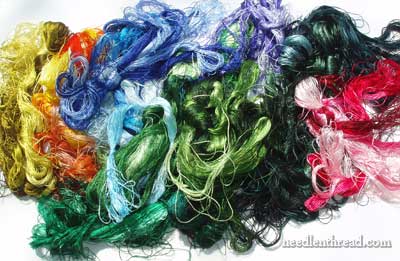
Here’s the heap of Chinese silk, and at first glance, I know it looks like a hairy mess of entangled silk. In fact, the threads are tied together in separate bunches, and when a bunch is picked up by the knot, it separates from the collection without any problem at all.
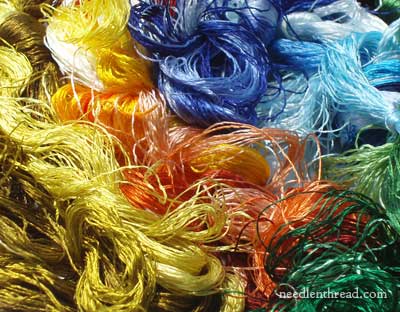
Chinese silk is a filament silk. It is reeled straight off the moth cocoon in a long thread, and because of this it has a very high sheen.
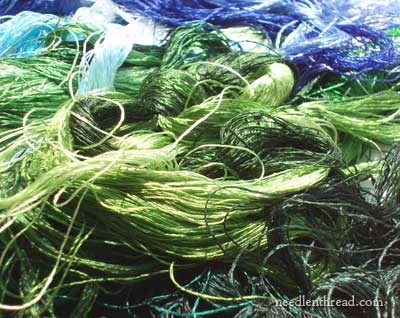
It can also be extremely fiddly to work with. The individual strands of silk easily catch on …. well. Anything! Chapped hands are the bane of any stitcher working with this thread, as it really does snag and catch at every opportunity on anything slightly rough. And in fact, even if you think you don’t have chapped hands, working with this thread might change your mind on that point. That having been said, if you work with this type of silk, you get used to handling it and controlling it after a while, so that you can reduce its likelihood to fly away and catch on everything.
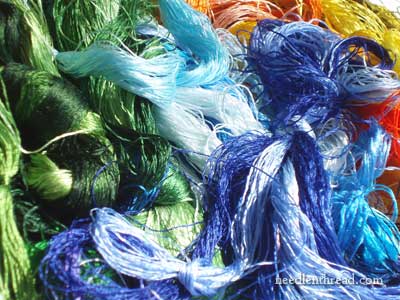
Chinese silk comes in an extremely wide range of colors and shades. In the US, the line of silk that is most similar to the silk in these photos is Eterna silk, which comes in 545 solid shades. You can read more about Eterna silk in this article comparing flat silk embroidery threads and in this stitching experiment with flat silks. You can see Eterna silk at work in these embroidered carnations, and also in the sky background on my Agnus Dei project, where Eternal silk was used for the sky, and was couched over with gold passing thread.
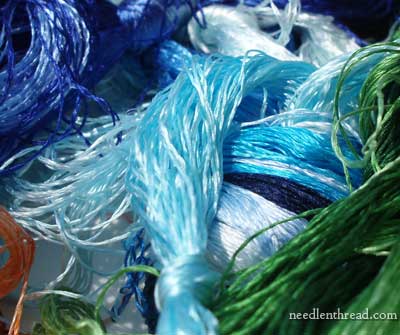
In the best quality Suzhou embroidery, the embroiderer separates these little strands of thread anywhere from 4 to 16 times, resulting in a thread that is barely visible to the human eye. How’d you like to stitch with that?!
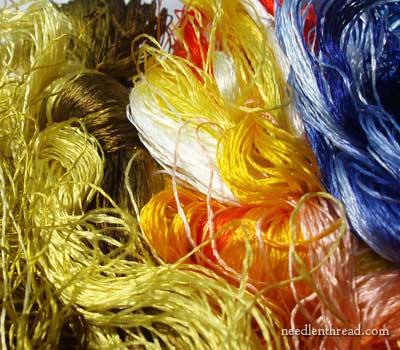
Because of its very fine nature and its ability to be separated into smaller and smaller strands for stitching, and because it’s silk and therefore quite strong, Chinese silk works well for embroidering tiny detailed elements – like eyes, in small portrait embroidery.
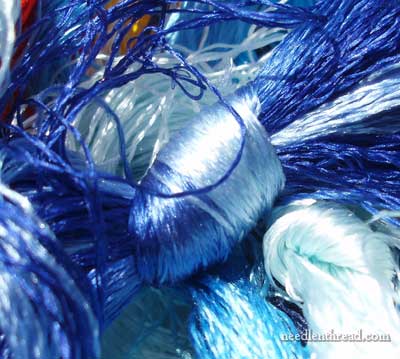
A little caveat here: Most Chinese embroidery silk that I’ve used – especially Eterna – is not perfect. In a typical skein of this kind of silk, you do run into flaws, so when you consider the price per skein as something incredibly affordable (Eterna runs around $.95 for a 5 meter, 12-ply skein), you have to keep in mind that the silk is not necessarily the best quality silk. You have to be willing to work around these imperfections, sometimes cutting and ending your thread where you wouldn’t necessarily want to, or sometimes avoiding a length of thread, because it is messed up. That having been said, I do still think it’s a usable thread, especially if you are looking for a very fine thread for working minuscule details on things. And I suppose I better mention again that it is pretty darned fussy to work with. If you’re new to using silk, this isn’t the thread I’d start with!
But the colors are pretty, aren’t they? And the sheen is amazing, isn’t it?
I do love looking at thread!







I’ve used silk thread like this… yes its fussy, but well worth the trouble. The finished product is absolutely beautiful. I’ve got a piece by Margaret Vant Erve of dragonflies and if I remember right buttercups (don’t quote me). Its on my list of to finish projects – its next. I’ll share when it gets done.
Sorry, I was wrong… it’s a pink wild rose. And we used Piper’s Flat Silks, I found using that was very similar to the chinese silks. A link to her project is http://www.vanterve.ca/workshops/2day/wildrose.html
Hi, Lynne! Thanks for that link! It’s a beautiful project! Comparing the Pipers silk to Eterna and the like, I think Pipers is better quality overall. It’s a much smoother thread, and not prone to having any flaws in it. I also like the fact that it is spooled – makes it much easier to handle!!
Good morning Mary,
I have a question. Since all I’ve ever used is cotton floss, DMC or off-brand DMC-like cotton floss. So, my question is…If I wanted to try silk thread how do I know how much to buy so that I don’t waste $? Um, maybe an example would be easier. Say you were doing a 4″ by 4″ project so that no background fabric would show through and you were using 4 colors – would you buy one on each color, or more than one? I’m trying to find an inexpensive way to try nice things.
P.S. I just bought some DMC “satin” (rayon) floss did you ever use it, and did you like it?
I sometimes think that I am overly obsesive about caring for my hands and applying hand cream but reading your comments about flat silk catching on absolutely everything reminds me why I am so obsesive 🙂
Arn’t the colours fabulous!
Dear Mary, I see that I have generated in you a great curiosity for those threads when I asked if you have used it !
I have received a bundle of greens some weeks ago and made a test doing “our kind” of long and short stitch without separating the strand, the result…was incredible.
Threads blends togheter in a lovely way and after a little time I took confidence with it because they catch on everything and have to say that stitching needs some experience.
This said, the low price and the fantastic range of shades makes this thread really lovely !!
Yes, It is beautiful thread and as a gift a friend gave me a silk embroidery picture from China. She was a catholic sister in china and was able to send back some items she liked. She has recently pasted away with breast cancer so I cherise the picture. It is very delicate stitchery of a orange and white cat looking at a praying mantis.So very beautiful. I have worked with silk thread and everything you talk about is so true but it is so silky and beatuiful. You just have ti try it.
Mary,
I’ve found a great way to smooth my hands without using hand lotion (I’m always worried that I’ll get lotion on my work). If you buy a bottle of pure glycerin at your local drug store and a little pump bottle from the dollar store you have the best hand “lotion” available in my opinion. Just put the glycerin in the pump bottle and after you wash your hands, while they are still wet, put just a drop or two in your palm and rub all over your hands. Then dry them. No grease, no smell and really smooth soft skin, BTW works on your legs too after you shave and you won’t have that dry skin going on.
I simply love looking at the beautiful, vibrant colors.
Thank you Mary for the information about flat silks. I asm tyrtying to find out everything I can about silk threads before purchasing them. So I don’t spend my hard earned money on the wrong silk threads. You always help with your comparings.
Hi there, Was wondering where can you get really good chenise embrodary threads from? iv be looked everywhere and i cant seem to fine the right kind?
Thank you for reading, hope to hear back coo.
Where did you get it from. I’m looking for it for ages.
You can find Chinese silk like this through Su Embroidery Studios, which is located in China. You can order from them online. You can also find it on eBay, in abundance.
I have absolute abundance of Chinese silk and love working with it. The person I get it from has 945 colour palette! Taming it is quite a feat but Oooh the results! I love the fact that as far as silk goes it’s ridiculously cheap. In fact it’s really cheap as far as thread goes and always worth the two week wait (from China) especially that it’s not too hard to be able to get a lovely bulk of it. Perfect for a complete thread addict.